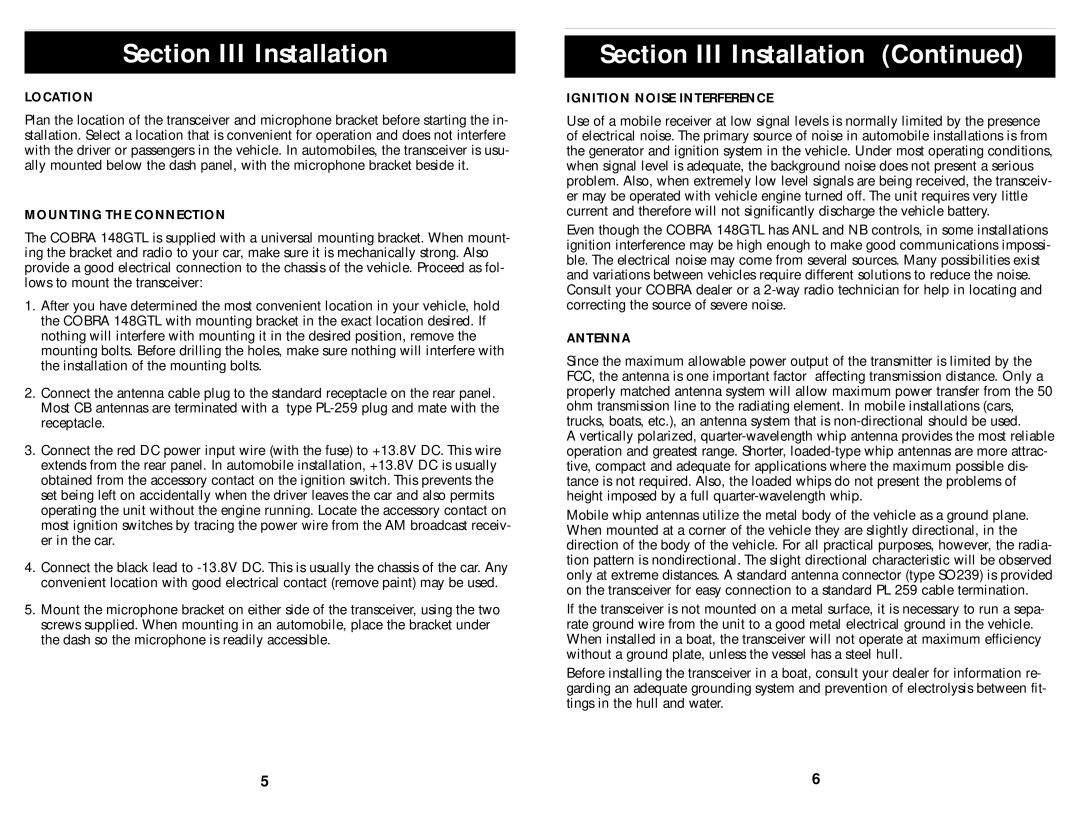Section III Installation
LOCATION
Plan the location of the transceiver and microphone bracket before starting the in- stallation. Select a location that is convenient for operation and does not interfere with the driver or passengers in the vehicle. In automobiles, the transceiver is usu- ally mounted below the dash panel, with the microphone bracket beside it.
MOUNTING THE CONNECTION
The COBRA 148GTL is supplied with a universal mounting bracket. When mount- ing the bracket and radio to your car, make sure it is mechanically strong. Also provide a good electrical connection to the chassis of the vehicle. Proceed as fol- lows to mount the transceiver:
1.After you have determined the most convenient location in your vehicle, hold the COBRA 148GTL with mounting bracket in the exact location desired. If nothing will interfere with mounting it in the desired position, remove the mounting bolts. Before drilling the holes, make sure nothing will interfere with the installation of the mounting bolts.
2.Connect the antenna cable plug to the standard receptacle on the rear panel. Most CB antennas are terminated with a type
3.Connect the red DC power input wire (with the fuse) to +13.8V DC. This wire extends from the rear panel. In automobile installation, +13.8V DC is usually obtained from the accessory contact on the ignition switch. This prevents the set being left on accidentally when the driver leaves the car and also permits operating the unit without the engine running. Locate the accessory contact on most ignition switches by tracing the power wire from the AM broadcast receiv- er in the car.
4.Connect the black lead to
5.Mount the microphone bracket on either side of the transceiver, using the two screws supplied. When mounting in an automobile, place the bracket under the dash so the microphone is readily accessible.
Section III Installation (Continued)
IGNITION NOISE INTERFERENCE
Use of a mobile receiver at low signal levels is normally limited by the presence of electrical noise. The primary source of noise in automobile installations is from the generator and ignition system in the vehicle. Under most operating conditions, when signal level is adequate, the background noise does not present a serious problem. Also, when extremely low level signals are being received, the transceiv- er may be operated with vehicle engine turned off. The unit requires very little current and therefore will not significantly discharge the vehicle battery.
Even though the COBRA 148GTL has ANL and NB controls, in some installations ignition interference may be high enough to make good communications impossi- ble. The electrical noise may come from several sources. Many possibilities exist and variations between vehicles require different solutions to reduce the noise. Consult your COBRA dealer or a
ANTENNA
Since the maximum allowable power output of the transmitter is limited by the FCC, the antenna is one important factor affecting transmission distance. Only a properly matched antenna system will allow maximum power transfer from the 50 ohm transmission line to the radiating element. In mobile installations (cars, trucks, boats, etc.), an antenna system that is
A vertically polarized,
Mobile whip antennas utilize the metal body of the vehicle as a ground plane. When mounted at a corner of the vehicle they are slightly directional, in the direction of the body of the vehicle. For all practical purposes, however, the radia- tion pattern is nondirectional. The slight directional characteristic will be observed only at extreme distances. A standard antenna connector (type SO239) is provided on the transceiver for easy connection to a standard PL 259 cable termination.
If the transceiver is not mounted on a metal surface, it is necessary to run a sepa- rate ground wire from the unit to a good metal electrical ground in the vehicle. When installed in a boat, the transceiver will not operate at maximum efficiency without a ground plate, unless the vessel has a steel hull.
Before installing the transceiver in a boat, consult your dealer for information re- garding an adequate grounding system and prevention of electrolysis between fit- tings in the hull and water.
5 | 6 |
